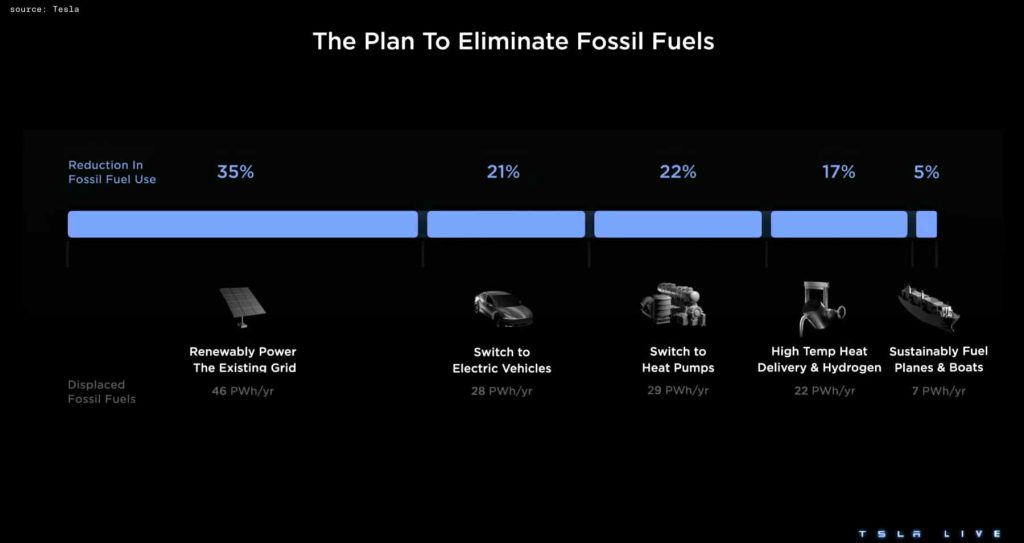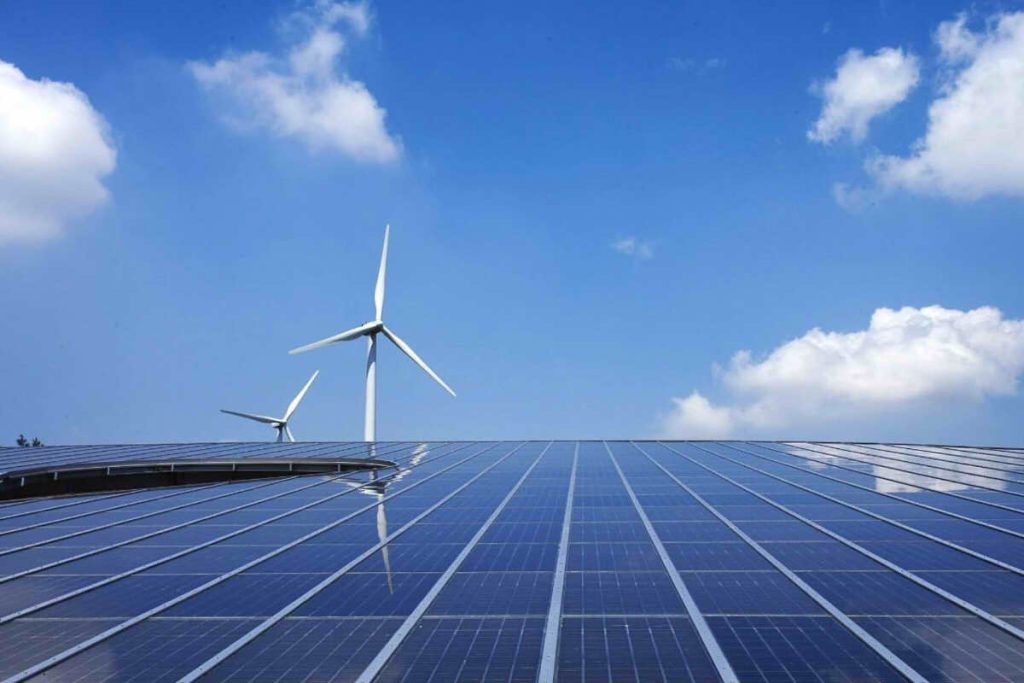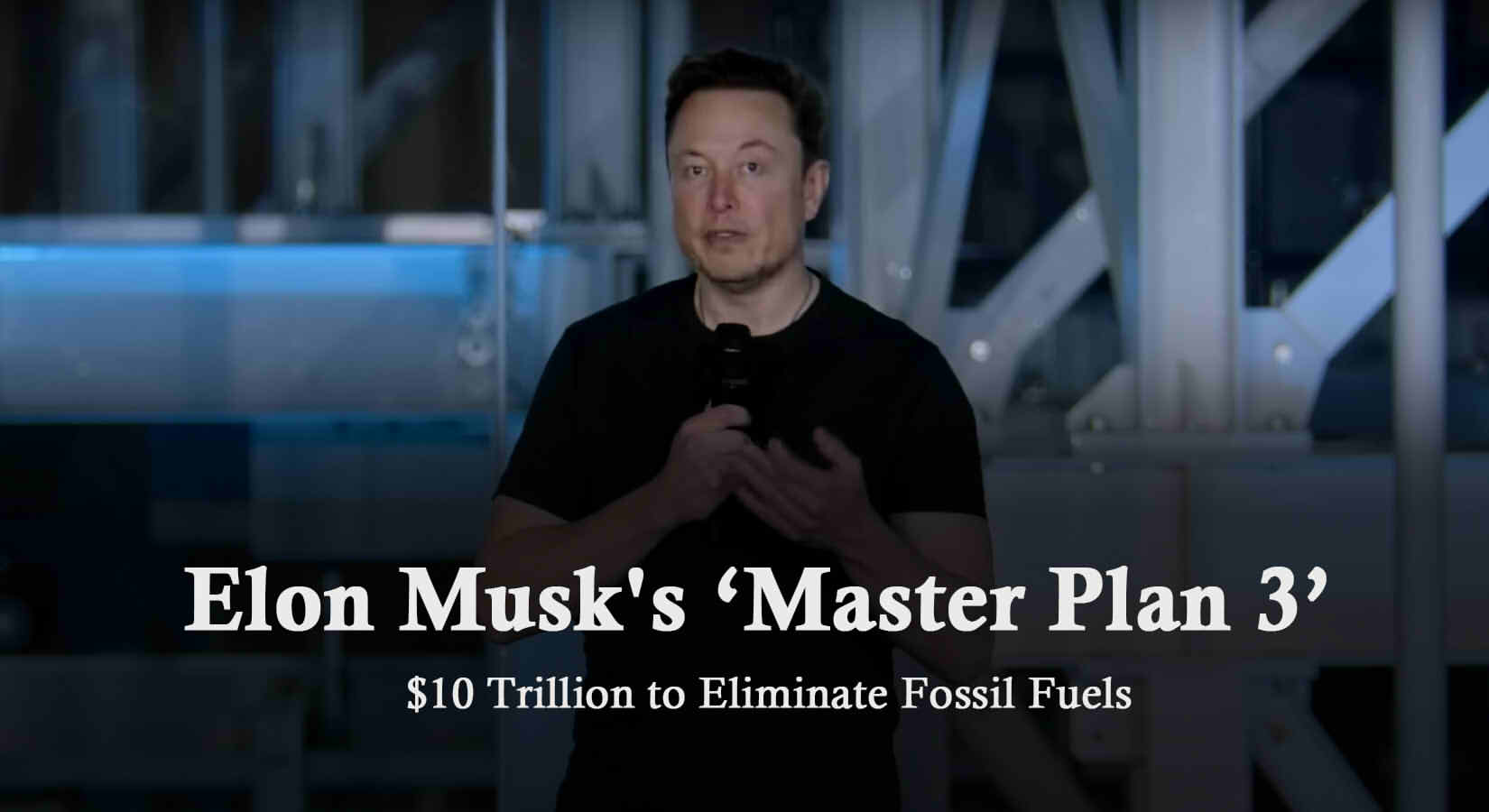On Tesla Investor Day, which ended the 2 of March, Elon Musk officially announced the third chapter of his ambitious plan, which had already been presented several times: embark on a path towards fully sustainable energy. Musk hopes that in the future, not just the automotive industry, but all of human society can adopt clean energy and, finally, move towards an energy society 100% sustainable.

Specifically, Musk believes the plan will be divided into five phases. The first with renewable energy to feed the existing network, increasing the use of solar and wind energy. In second place, the complete transition from traditional cars to electric cars. Then, promote large-scale heat pumps in homes, companies and industries. Then, replace industrial heat with something like hydrogen. Finally, allow planes and ships to also use sustainable energy, to achieve a sustainable energy transition of the entire society.
From this point of view, Tesla's goal is no longer focused only on the automotive industry, but it is a great vision that involves the entire society. Musk's budget is $10 trillion, which is not a small amount. Therefore, This plan is more like a call to action for all of humanity to work together..
Five Steps from Fossil to Sustainable Energy
At the beginning of Tesla Investor Day, Musk first analyzed the current energy structure on earth. He said that at this stage, the 80% of the planet's energy comes from fossil energy, and only around 20% It's clean energy. The disadvantages of relying too much on fossil energy are very obvious. Earth's population is growing and fossil energy reserves are limited. Therefore, humanity must start exploring sustainable energy sources.

The First Step
Musk said current clean energy development is not comprehensive enough. There are places where wind and solar energy conditions are very good. Besides, the development of wind and solar energy does not take up much space on land. Companies can build wind and solar energy facilities in places like deserts and even clean energy generation facilities in the oceans, that cover the 70 percent of the planet.
Elon Musk imagines that the first step towards truly sustainable energy is to change the current energy mix. A reduction can be achieved 35% in the use of fossil fuels building the network through renewable energy.
The second step
The second step is the mass production of electric cars. In Musk's opinion, compared to engines, electric cars are more efficient. An interesting example was given at the launch event, namely, that the energy used to boil water to cook pasta can be used to drive 1 km in the Model 3. Musk also mentioned several times before that Tesla's goal is to achieve annual production of 20 millions of new cars and reduce the use of fossil fuels by a 21%.
The third step
In the third stage, The discussion focuses on the use of thermal energy. Musk proposes promoting large-scale heat pumps in homes, companies and industries. Currently, Heating in the home and in industry is mainly based on natural gas, which is also a source of fossil energy. Musk believes heat pumps can be used to heat homes and industries, and that the change could reduce the use of fossil fuels by 22%.
The Fourth Step
The fourth step is the transformation of industries. Industries at this stage have a high demand for thermal energy. And industries like steel require high-temperature furnaces to produce. Musk's solution is hydrogen energy, which according to him can reduce fossil fuels by 17% through industrial production.
The Fifth Step
The final step is the transformation of large-scale electrification. The energy density of current batteries is not enough to change the energy structure of airplanes and ships. Nevertheless, Musk believes that in the future these vehicles should be electrically driven, and even in the aviation sector more electrical systems could be used. In the future, humans can redesign planes and ships to make them more suitable for electrification. By doing so, there will be a reduction of 5% in fossil fuels.
Is it an Energy Future? 100% Renewable Unattainable?
With these five visions, Musk considers it possible to create an energy planet 100% sustainable. The entire plan will cost 10 billions of dollars. Nevertheless, Musk also admits that there is still some distance from this goal, and various developments also need to depend on the Earth's raw material resources.
According to Musk, Humans should use raw material resources more rationally to help achieve better energy. 100% sustainable. Resource development must be done more efficiently and greener. It is also necessary to establish a perfect recycling mechanism to achieve high-quality sustainable development..

So is it a future of energy 100% unattainable renewable? The Renewable Energy Report 2022 published by the International Energy Agency notes that renewable energy installations in several countries have accelerated significantly, driven by the energy crisis. And the global increase in installed capacity over the next five years is expected to be almost double the increase in the previous five years.. The report predicts that between 2022 Y 2027, Globally installed renewable energy generation capacity will increase by 2.400 GW, which represents more than 90% of the global increase in electricity. At the beginning of 2025, Renewable energies will surpass coal as the main source of electricity in the world.
Judging by this trend, renewable energy is at a critical moment. And technologies like solar and wind, that are fundamental for the transformation of the global energy system, will be the support of this phase.
But these energy sources also face several challenges.. Wind and solar energy is intermittent by nature. This intermittency makes it difficult for wind and solar energy to remain stable and produce the required power smoothly.. Statistically, Even the most efficient wind and solar farms are only generating optimal energy on 30% weather. Therefore, electricity storage and transmission control are also directions that need strong development.
The energy storage business is also one of Tesla's core businesses. Tesla is actively building the product Megapack, which has been updated to the sixth generation. And it is also deploying 16GWh in 50 countries around the world, advancing rapidly. Tesla is also building charging stations around the world, that will be open to more car brands than just Tesla.
The Great Potential of the Special Cable Industry for New Energies
As professional cable manufacturer, ZMS sees the great potential of special cables for new energies at a time when electrification has become irreversible. Special cables for new energy are applied to fields such as photovoltaics, wind energy, electric vehicles, charging points and energy storage. At the height of the development of renewable energies, the special cables industry, directly related to them, you will experience enormous development opportunities.

Characteristics of the Renewable Energy Cable Industry
Cyclicity
The development of the special energy cables industry is closely related to that of derived industries such as photovoltaics and electric vehicles.. The cyclical nature of industry development is mainly influenced by downstream market demand.
In the field of photovoltaics, The new installed capacity of photovoltaic power plants is high during the period of rapid economic development and high government subsidies. In the period of slowdown in economic development, the new installed capacity of photovoltaic power plants is low. With the gradual promotion of access to the photovoltaic parity network, industry cyclicality tends to level out. In recent years, the new energy vehicle industry is still in the industry growth period, which does not yet reflect obvious cyclical characteristics.
Regional
Special cables for the renewable energy industry are mainly supplied to photovoltaic module manufacturers, car harness companies, etc. The regional nature of the industry is related to the distribution of downstream customers and the industrial chain. Currently, Countries vigorously developing renewable energy are mainly concentrated in Europe, USA, China and India. Cable industry giants also focus on these high-end cable markets, which causes a gradual increase in the overall concentration, especially in mature markets. auto parts industry, including electric vehicle cables, It also has a strong geographic presence.
Seasonality
The production and sales of the electrical cable industry specials are mainly influenced by the seasonality of the photovoltaic and electric vehicle industries. The prosperity of the photovoltaic power generation market directly affects the rise and fall of the photovoltaic industry chain. Under the condition that supporting policies are stable, PV power generation market scale and feed-in price are expected to be stable and guaranteed, and the photovoltaic cable industry does not show obvious seasonality.
The production and sales of electric vehicle cables are strongly influenced by the production plans of the electric vehicle industry. Vehicle manufacturers typically increase production plans in the fourth quarter of each year to deal with the impact of reduced holiday production.. And the second half of the year is generally a period of concentration of government subsidies and a clear period of subsidy policy for the next year. Therefore, the new energy special cables industry generally has a higher sales scale in the second half of the year.
Special Cables Industry for New Energy – Technological Level
Cables are mainly used for the transmission of electricity and electrical power signals.. Its function is carried out mainly through physical and electrical properties. The use environment and technical requirements of different fields have different requirements for the performance of special support cables..
Photovoltaic Cables
Los photovoltaic cables are exposed to the external natural environment for a long time, and are subject to strong ultraviolet radiation. They are also often exposed to high temperatures, low temperature, rain, snow, frost, humidity and pollution. And they need to withstand various external mechanical forces (like gravity, traction, wind impact and vibration, etc.). Therefore, There are strict evaluation standards for each performance of solar cables. Besides, since the required useful life of the photovoltaic modules is 25 years, The service life of photovoltaic support cables is longer than that of ordinary cables.
Cables for Electric Vehicles
The high voltage cable inside the electric vehicle needs to be flexible, wear and corrosion resistant. In addition to these, The following features are required:
1. High voltage resistance. Los high voltage cables of electric vehicles need to transmit energy from the battery to each subsystem, so the cables must meet the transmission of high voltage and high current.
2. Heat and aging resistance. Since electric vehicle cables carry high currents for a long time, Its power is high and a lot of heat is generated, so they need to have strong heat resistance and be able to resist thermal aging.
3. Electromagnetic compatibility. To avoid electromagnetic radiation and interference to surrounding equipment, The high-voltage cables of electric vehicles must have a shielding structure against electromagnetic interference to ensure the safe and normal operation of electric vehicles..
4. Flame retardant. When an electric vehicle cable catches fire, needs to be able to limit the flame within a range and extinguish itself within a limited time. Therefore, HV EV cables also need to have good flame retardancy for low smoke.
Charging Cables for Electric Vehicles
Electric vehicle charging cable is mainly used to connect new energy vehicles with charging poles. Being exposed for a long time, needs to have good physical and mechanical properties. Besides, higher requirements for weight are required, the flexibility and corrosion resistance of the cables. Besides, with the development of electric vehicles, The EV charging cable should also have the role of transferring the corresponding battery power and general information status of the charging vehicle to the charging pole.

Technical Characteristics of the Cable Industry for Renewable Energy
The technical core of cable production includes three parts: material, structure design and production process. Materials directly affect product quality and performance rate. Product structure design affects safety, reliability, wear resistance, tensile strength and other comprehensive product characteristics and material consumption. The production process is the technical guarantee to carry out the structural design of the product.
Due to the special characteristics of the use environment, Photovoltaic and electric vehicle cables pose higher requirements for the performance of materials and cable production processes.
The performance stability of photovoltaic and electric vehicle cables directly affects the efficiency of photovoltaic power generation and the safety and reliability of electric vehicle operation.. Therefore, This special cable is subject to a series of performance tests, including structural dimensional inspection, conductor dc resistance test, finished product voltage test, insulation resistance test, performance testing of insulation and covering materials, ozonation resistance test, thermal life test, acid and alkali resistance test, halogen-free smoke density test, etc.
ZMS Sees Renewable Energy Vision Complete
Musk's concept of a complete transition to renewable energy is not unworkable in the opinion of ZMS Cable. To borrow Musk's words at the end of his speech, “We live on the planet and we are all investors in it. We can rely on scientific calculation and analysis to do something for the planet, not only in the imagination”. Faced with the rise of renewable energy, ZMS will also take advantage of the wind and try to improve the production technology of special electrical cables to make a contribution to clean and sustainable development.

